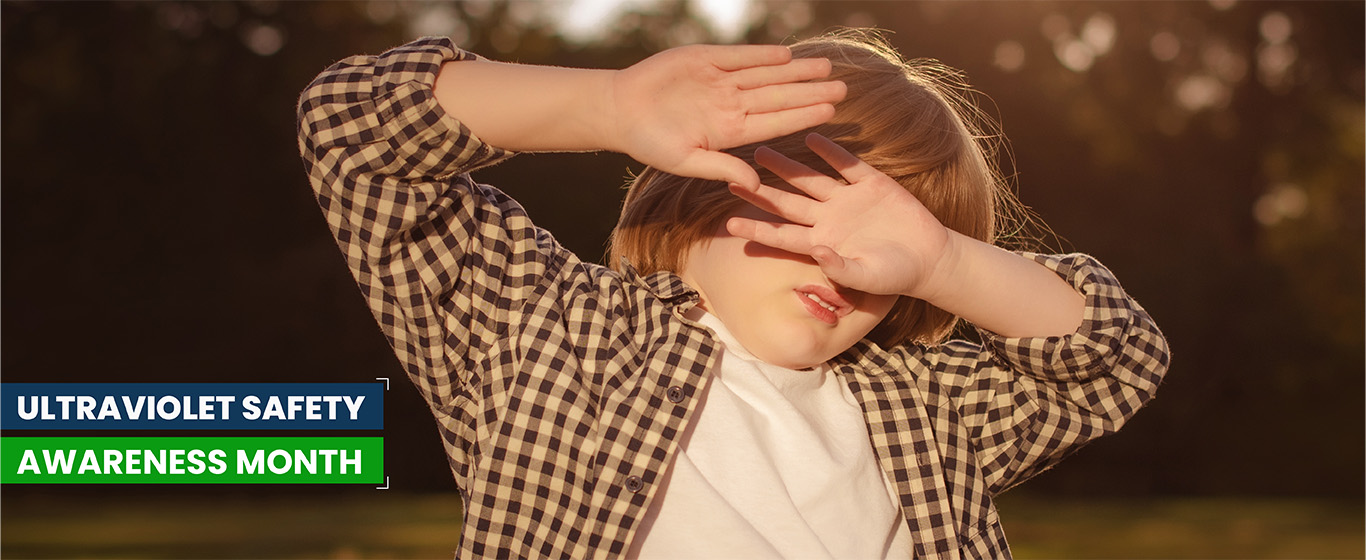
July is UV Safety Awareness Month. The month promises to raise awareness about the harmful effects of ultraviolet (UV) radiation and educates people on how to take care of their eyes and skin. UV rays that are dissipated from the sun can cause severe health issues, including skin cancer, cataracts, and macular degeneration.
Ultraviolet radiation (UVR) spans electromagnetic wavelengths from 100 to 400 nm and is classified into three categories: ultraviolet A (UVA) (315–400 nm), ultraviolet B (UVB) (280–315 nm), and ultraviolet C (UVC) (100–280 nm). However, environmental photo biologists often categorize UVA as 320–400 nm, UVB as 290–320 nm, and UVC as 200–290 nm. UVR is invisible to the human eye, and it’s true that shorter wavelengths could be more risky as it carries more energy and can cause eye damage. For example, the biological damage potential at 300 nm is 600 times greater than at 325 nm.
Parts of Eye Susceptible to UV Radiation :
Long-term exposure to the sun can damage various parts of the eyes due to UV radiation. Below we have discussed various parts of the eye that can be damaged due to UVR exposure
Conjunctiva:
Wind, dust, and UV radiation can cause pinguecula, a non-cancerous growth on the conjunctiva. Pinguecula appears as a white or yellow raised area and can progress to pterygium, a white, wedge-shaped growth over the cornea. Pterygium can lead to corneal inflammation, scarring, eye pain, and potential vision loss.
Cornea:
UV exposure can cause acute corneal inflammation or keratitis.Symptoms include sudden eye pain, tearing, and blurred vision, often occurring 2-3 hours after exposure and lasting for 2-3 days.Common sources include reflections from snow-covered surfaces and intense UV radiation from welding.
Lens
UV radiation can accelerate the clouding of the lens that may end in development of cataracts and could impair vision.According to WHO, cataracts have caused blindness in about 16 million people globally.Overexposure to UV radiation, an avoidable factor, contributes to 20% of cataract cases.
Macular Degeneration
Macular degeneration is a leading cause of blindness in older adults. It is one of the leading reasons for cumulative UV damage to the eye. It occurs when the macula, the central part of the retina, gets damaged permanently. This condition affects central vision, making reading, watching TV, using a computer, or recognising faces difficult.
Photokeratitis
Photokeratitis is a painful condition resulting from too much exposure to the sun’s rays, including those reflected off water, snow, or other surfaces like car glasses etc. Although temporary, it is very uncomfortable and indicates that your eyes have had excessive UV exposure. Some describe photokeratitis as sunburn on the eyes.
Care Tips to Combat UV Rays
When choosing sunglasses, don’t focus on the color or darkness of the lenses. Instead, prioritize sunglasses that block UV rays. The ability to block UV light is not determined by the price or the darkness of the lenses.Always look for sunglasses that offer 100 percent UV protection, ensuring they block both UV-A and UV-B rays.
Opt for wrap-around styles. Ideally, your sunglasses should wrap around your temples, preventing sunlight from entering from the sides. Along with your sunglasses, you should wear a broad-brimmed hat to protect your eyes further. Those who are in the habit of wearing contact lenses with UV protection, don’t forget to wear sunglasses. Don’t be deceived by cloudy skies. The sun’s rays can penetrate haze and thin clouds, causing eye damage any time of the year, not just in summer.
Protect your eyes during peak sun times. Sunglasses should be worn whenever you’re outside, especially during the early afternoon and when you are traveling to a hilly station at higher altitudes where UV light is more intense. Never look directly at the sun. Directly viewing the sun, even during an eclipse, can cause solar retinopathy, damaging the retina due to solar radiation.
Don’t forget about protecting children’s eyes. Kids are also at risk, so ensure they wear hats and sunglasses. Additionally, try to keep them away from the sun. Make sure that your childrens are indoors during the early afternoon hours when the UV rays are strongest.
Ayurvedic remedies for eyes to reduce UV effects
Ayurveda offers several natural remedies to help protect and maintain the health of your eyes, including ways to mitigate the effects of UV rays. Here are some Ayurvedic tips and practices:
Triphala Eye Wash:
Triphala is considered one of the best fruits consisting of (Amalaki, Bibhitaki, and Haritaki) known for its rejuvenating properties. Take an eye wash out of triphala by soaking it overnight and in the morning, strain the liquid and use it to wash your eyes. This can help soothe and cleanse the eyes.
Cucumber Slices:
Cool cucumber slices over your closed eyes can help soothe and hydrate them. Cucumber has a cooling effect and it can definitely reduce eye strain to a great extent.
Ghee (Clarified Butter):
Applying a small amount of pure cow ghee to the eyelids before bedtime can help nourish and strengthen the eyes. Ghee has been traditionally used in Ayurveda for its healing properties.
Amla (Indian Gooseberry):
Amla supports overall eye health and therefore if one starts consuming amla juice on a daily basis it can help him protect his eyes from oxidative stress.
Protective Herbs:
Ayurvedic herbs like Saptamrit Lauh and Maha Triphala Ghritam are formulated to support eye health. Consult an Ayurvedic practitioner for appropriate dosages and recommendations.
Palming Exercise:
Rub your hands together to generate warmth, then place your palms over your closed eyes. Doing such exercise helps to relax the eye muscles and reduces strain.
Proper Nutrition:
To protect your eyes from UV damage, people start intake of foods which are rich in vitamin A, such as carrots, sweet potatoes, and leafy greens, to your diet. These nutrients support overall eye health and can help mitigate the effects of UV damage.
You Can Also Read For More Posts
How to cure dry eyes permanently
How does smoking cause cataracts
To Know More, Talk to our Consultant. Dial +91-8235808080
